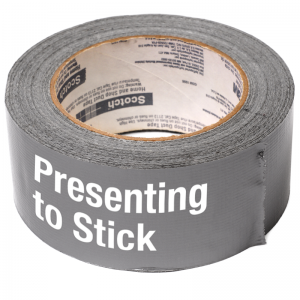Presenting (Teaching) to Stick
 This page is a support resource for the staff development sessions “Telling Stories with Data,” “Presenting to Stick” and/or “Teaching to Stick.”
This page is a support resource for the staff development sessions “Telling Stories with Data,” “Presenting to Stick” and/or “Teaching to Stick.”
DESCRIPTION: A presentation should communicate as clearly and simply as possible. We will discuss how a little bit of brain science, a little bit of graphic design and all the things you already know about how people learn can come together to help people walk out the door remembering the main ideas of your presentation.
Session Overview
A “sticky” idea is one that people recall long after you are done talking to them. The good news is that while there is a bit of art to delivering a presentation, there is a lot more science. There are PRACTICAL strategies you can use to make your ideas stay with an audience.
- “The Curse of Knowledge” is cognitive bias that leads better-informed parties to find it extremely difficult to think about problems from the perspective of lesser-informed parties.
- Sticky ideas have very distinctive traits. (Success Model)
- Our job as a presenter is to help the audience absorb our information.
- Aim for simplicity in all facets of your presentation.
- If you create a mystery people will stay with you and pay attention. Open gaps in curiosity by asking questions and not immediately answering them.
- Pictures are better than words. Your cell phone likely has a camera, snap a picture or a short video.
- Data is meaningless if you do not provide an appropriate scale.
- Don’t create your own competition. People cannot READ and LISTEN at the same time. Use as little text as possible.
- Break it up
- Use Powerful Imagery
- Presenting data in a “shape” does not inherently help your message. Charts are for communicating ideas, not delivering data.
Presentation Construction
There are 3 parts to a presentation.
- Notes
- Handout
- Slides
Do your work in that order.
Tools I use:
- Notes/Script: Google Doc
- Handouts: Google Doc, WordPress, PDF, etc.
- Slides: Google Presentation
- During Presentation: Google Drive app on iPad
Resources
Books
- ‘Made to Stick‘ by Chip and Dan Heath
- PDF: Success Model
- ‘Brain Rules: 12 Principles for Surviving and Thriving at Work, Home, and School‘ by John Medina
- PDF: Brain Rules References
- VIDEOS: Brain Rules Videos
- ‘Presentation Zen‘ by Garr Reynolds
- ‘slide:ology: the Art & Science of Creating Great Presentations‘ by Nancy Duarte
- ‘Resonate: Present Visual Stories that Transform Audiences‘ by Nancy Duarte
Gale Virtual Reference Library
- eBOOK: Jensen, Eric. Teaching with the Brain in Mind, 2nd ed., Rev. and Updated. Alexandria, VA: Association for Supervision and Curriculum Development, 2005. Gale Virtual Reference Library.
- ARTICLE: “Visual Learning Tools—Videos and Photos.” Web 2.0: How-To for Educators. Gwen Solomon and Lynne Schrum. Washington, DC: International Society for Technology in Education, 2010. 101-116. Gale Virtual Reference Library
Web Sites & Articles
- “The David Attenborough Style of Presentation” (PDF) By Will Ratcliff, Georgia Tech University
- “Why Cognitive Load Theory Needs to be Applied to Every Presentation” By Scott Schwertly
- “6 Presentation Design Dos and Don’ts“
- http://www.presentationzen.com/
- Dean Shareski Presentation “Let’s Get Visual”
Charts & Graphs
Locating Photos & Media
You should carefully read the license of these free resources and add attribution to a “Credits” slide if used.
- Use the camera on your smart phone or mobile device!
- This page will help you find Openly licensed Educational Resources (OER) to use within presentations.
- Videos for Professional Development
- Digital Literacy: Find Free (and Legal) Images for Your Classroom
- Compfight: creative commons search at Flickr
- Wikimedia commons
- Unsplash
- Picjumbo
- The Noun Project
- Iconfinder
- 74 free stock photo resource
Google Presentation Templates
On-Screen Timers
- Apimac Timer (on your LPS Macintosh laptop)
- http://timer.onlineclock.net/
- http://www.online-stopwatch.com/
Thinking Devices
- PDF: Thinking Devices
Multitasking Myth
- http://www.thenewatlantis.com/publications/the-myth-of-multitasking
- http://www.npr.org/templates/story/story.php?storyId=95256794
University of Minnesota
- SLIDESHOW: Research Presentation by ChristinaPetersen, Ph.D & David Langley, Ph.D, University of Minnesota Center for Teaching and Learning
Updated January 8, 2018

You must be logged in to post a comment.